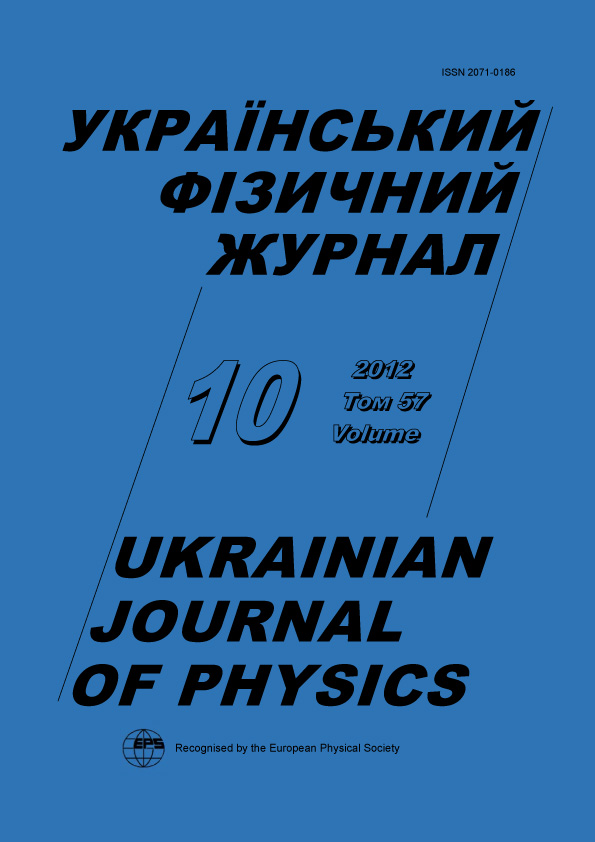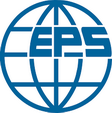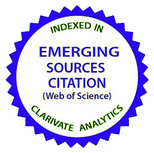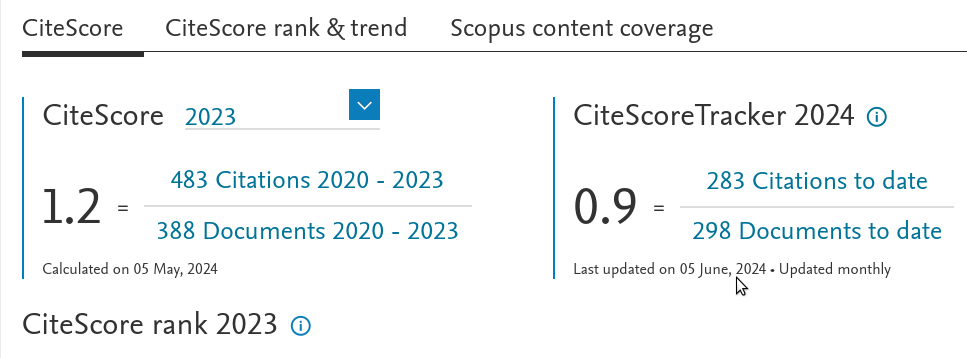Polar Properties and Hysteresis Loops in Multilayered Thin Films Ferroelectric/Virtual Ferroelectric
DOI:
https://doi.org/10.15407/ujpe57.10.1038Keywords:
-Abstract
In the framework of Landau–Ginzburg–Devonshire (LGD) phenomenological theory, the influence of misfit strains, surface energy, and finite-size effects on phase diagrams, polar properties, and hysteresis loops has been calculated for multilayered thin films of the type ferroelectric/virtual ferroelectric. The influence of elastic deformations that arise at the interface thin film–substrate owing to a mismatch between the lattice constants in the film and the substrate on the phase diagrams of multilayered thin films virtual ferroelectric SrTiO3/ferroelectric BaTiO3 has been studied for the first time. In contrast to bulk BaTiO3, in which only four phases (cubic, tetragonal, orthorhombic, and rhombohedral) can exist, it turned out that six thermodynamically stable BaTiO3 phases (paraelectric phase and tetragonal (FEc), two monoclinic (FEaac and FEac), and two orthorhombic (FEa and FEaa) ferroelectric phases) can exist in multilayered SrTiO3/BaTiO3 films. The main polar properties of hysteresis loops (shape, coercive field, and spontaneous polarization) in thin multilayered SrTiO3/BaTiO3 films are calculated. It is shown that the system demonstrates a strong dependence of its polar properties on the thickness of SrTiO3 and BaTiO3 layers, as well as on the elastic misfit strains, with SrTiO3 playing the role of dielectric layer: the thicker the layer, the stronger is the
depolarization field, which, in its turn, reduces the spontaneous polarization in the BaTiO3 film.
References
R. Nath, S. Zhong, S.P. Alpay, B.D. Huey, and M.W. Cole, Appl. Phys. Lett. 92, 012916 (2008).
https://doi.org/10.1063/1.2825287
J.Y. Jo, R.J. Sichel, E.M. Dufresne, H.N. Lee, S.M. Nakhmanson, and P.G. Evans, Phys. Rev. B 82, 174116 (2010).
J.Y. Jo, R.J. Sichel, H.N. Lee, S.M. Nakhmanson, E.M. Dufresne, and P.G. Evans, Phys. Rev. Lett. 104, 207601 (2010).
V.A. Stephanovich, I.A. Luk'yanchuk, and M.G. Karkut, Phys. Rev. Lett. 94, 047601 (2005).
https://doi.org/10.1103/PhysRevLett.94.047601
D.G. Schlom, L.-Q. Chen, X. Pan, A. Schmehl, and M.A. Zurbuchen, J. Am. Ceram. Soc. 91, 2429 (2008).
https://doi.org/10.1111/j.1551-2916.2008.02556.x
X. Wu, K.M. Rabe, and D. Vanderbilt, Phys. Rev. B 83, 020104 (2011).
A.L. Roytburd, S. Zhong, and S.P. Alpay, Appl. Phys. Lett. 87, 092902 (2005).
https://doi.org/10.1063/1.2032601
E. Bousquet, M. Dawber, N. Stucki, C. Lichtensteiger, P. Hermet, S. Gariglio, J.-M. Triscone, and P. Ghosez, Nature 452, 732 (2008).
https://doi.org/10.1038/nature06817
D.D. Fong, G.B. Stephenson, S.K. Streiffer, J.A. Eastman, O. Auciello, P.H. Fuoss, and C. Thompson, Science 304, 1650 (2004).
https://doi.org/10.1126/science.1098252
M.B. Okatan, J.V. Mantese, and S.P. Alpay, Acta Mater. 58, 39 (2010).
https://doi.org/10.1016/j.actamat.2009.08.055
M.B. Okatan, I.B. Misirlioglu, and S.P. Alpay, Phys. Rev. B 82, 094115 (2010).
https://doi.org/10.1103/PhysRevB.82.094115
I.B. Misirlioglu, G. Akcay, and S. Zhong, J. Appl. Phys. 101, 036107 (2007).
https://doi.org/10.1063/1.2433766
N.A. Pertsev, V.G. Kukhar, H. Kohlstedt, and R. Waser, Phys. Rev. B 67, 054107 (2003).
https://doi.org/10.1103/PhysRevB.67.054107
A. Sharma, Z.-G. Ban, S.P. Alpay, and J.V. Mantese, J. Appl. Phys. 95, 3618 (2004).
https://doi.org/10.1063/1.1649460
Z.-G. Ban and S. P. Alpay, Appl. Phys. Lett. 82, 3499 (2003).
https://doi.org/10.1063/1.1576503
B.D. Qu, W.L. Zhong, and R.H. Prince, Phys. Rev. B 55, 11218 (1997).
https://doi.org/10.1103/PhysRevB.55.11218
K.H. Chew, Y. Ishibashi, and F.G. Shin, Ferroelect. 357, 133 (2007).
https://doi.org/10.1080/00150190701542430
N.A. Pertsev, A.G. Zembilgotov, and A.K. Tagantsev, Phys. Rev. Lett. 80, 1988 (1998).
https://doi.org/10.1103/PhysRevLett.80.1988
J.S. Speck and W. Pompe, J Appl. Phys. 76, 466 (1994).
https://doi.org/10.1063/1.357097
G. Rupprecht and R.O. Bell, Phys. Rev. A 135, 748 (1964).
https://doi.org/10.1103/PhysRev.135.A748
C.-L. Jia, V. Nagarajan, J.-Q. He, L. Houben, T. Zhao, R. Ramesh, K. Urban, and R. Waser, Nature Mater. 6, 64 (2007).
https://doi.org/10.1038/nmat1808
G.A. Smolenskii, V.A. Bokov, V.A. Isupov, N.N. Krainik, R.E. Pasynkov, and A.I. Sokolov, Ferroelectrics and Related Materials (Gordon and Breach, New York, 1984).
Y.L. Wang, A.K. Tagantsev, D. Damjanovic, N. Setter, V.K. Yarmarkin, and A.I. Sokolov, J. Appl. Phys. 101, 104115 (2007).
https://doi.org/10.1063/1.2733744
A. Fleury and J.M. Worlock, Phys. Rev. 174, 613 (1968).
https://doi.org/10.1103/PhysRev.174.613
H. Uwe and T. Sakudo, Phys. Rev. B 15, 337 (1977).
https://doi.org/10.1103/PhysRevB.15.337
The order of magnitude g~10^-10 V m^3/K corresponds to ordinary "rigid" ferroelectrics like PTO, whereas g~ 10^-9 V m^3/K seems to be more typical of virtual ferroelectrics, "soft" ferroelectrics, and ferroelectric semiconductors.
A. Pertsev, A.K. Tagantsev, and N. Setter, Phys. Rev. B 61, 825 (2000).
Downloads
Published
How to Cite
Issue
Section
License
Copyright Agreement
License to Publish the Paper
Kyiv, Ukraine
The corresponding author and the co-authors (hereon referred to as the Author(s)) of the paper being submitted to the Ukrainian Journal of Physics (hereon referred to as the Paper) from one side and the Bogolyubov Institute for Theoretical Physics, National Academy of Sciences of Ukraine, represented by its Director (hereon referred to as the Publisher) from the other side have come to the following Agreement:
1. Subject of the Agreement.
The Author(s) grant(s) the Publisher the free non-exclusive right to use the Paper (of scientific, technical, or any other content) according to the terms and conditions defined by this Agreement.
2. The ways of using the Paper.
2.1. The Author(s) grant(s) the Publisher the right to use the Paper as follows.
2.1.1. To publish the Paper in the Ukrainian Journal of Physics (hereon referred to as the Journal) in original language and translated into English (the copy of the Paper approved by the Author(s) and the Publisher and accepted for publication is a constitutive part of this License Agreement).
2.1.2. To edit, adapt, and correct the Paper by approval of the Author(s).
2.1.3. To translate the Paper in the case when the Paper is written in a language different from that adopted in the Journal.
2.2. If the Author(s) has(ve) an intent to use the Paper in any other way, e.g., to publish the translated version of the Paper (except for the case defined by Section 2.1.3 of this Agreement), to post the full Paper or any its part on the web, to publish the Paper in any other editions, to include the Paper or any its part in other collections, anthologies, encyclopaedias, etc., the Author(s) should get a written permission from the Publisher.
3. License territory.
The Author(s) grant(s) the Publisher the right to use the Paper as regulated by sections 2.1.1–2.1.3 of this Agreement on the territory of Ukraine and to distribute the Paper as indispensable part of the Journal on the territory of Ukraine and other countries by means of subscription, sales, and free transfer to a third party.
4. Duration.
4.1. This Agreement is valid starting from the date of signature and acts for the entire period of the existence of the Journal.
5. Loyalty.
5.1. The Author(s) warrant(s) the Publisher that:
– he/she is the true author (co-author) of the Paper;
– copyright on the Paper was not transferred to any other party;
– the Paper has never been published before and will not be published in any other media before it is published by the Publisher (see also section 2.2);
– the Author(s) do(es) not violate any intellectual property right of other parties. If the Paper includes some materials of other parties, except for citations whose length is regulated by the scientific, informational, or critical character of the Paper, the use of such materials is in compliance with the regulations of the international law and the law of Ukraine.
6. Requisites and signatures of the Parties.
Publisher: Bogolyubov Institute for Theoretical Physics, National Academy of Sciences of Ukraine.
Address: Ukraine, Kyiv, Metrolohichna Str. 14-b.
Author: Electronic signature on behalf and with endorsement of all co-authors.













